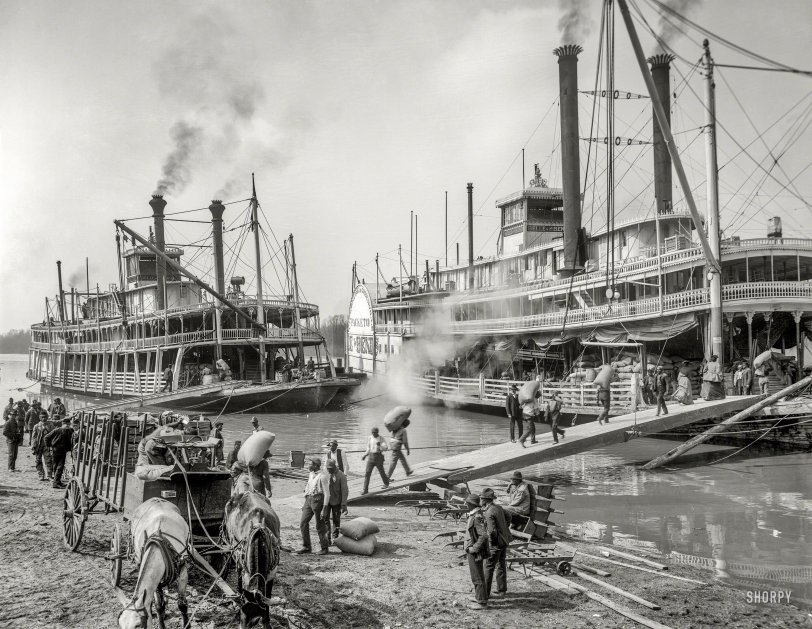


Framed or unframed, desk size to sofa size, printed by us in Arizona and Alabama since 2007. Explore now.
Shorpy is funded by you. Patreon contributors get an ad-free experience.
Learn more.

- Lost in Toyland
- And without gloves
- If I were a blindfolded time traveler
- Smoke Consumer Also Cooks
- Oh that stove!
- Possibly still there?
- What?!?
- $100 Reward
- Freeze Frame
- Texas Flyer wanted
- Just a Year Too Soon
- WWII -- Replacing men with women at the railroad crossing.
- Yes, Icing
- You kids drive me nuts!
- NOT An Easy Job
- I wonder
- Just add window boxes
- Icing Platform?
- Indiana Harbor Belt abides
- Freezing haze
- Corrections (for those who care)
- C&NW at Nelson
- Fallen Flags
- A dangerous job made worse
- Water Stop
- Passenger trains have right of way over freights?
- Coal
- Never ceases to amaze me.
- Still chuggin' (in model form)
- Great shot
Print Emporium
Two Misses in Memphis: 1906

Memphis circa 1906. "A Mississippi River landing." The sidewheeler Belle of the Bends taking on cargo alongside the sternwheeler Belle of Calhoun. 8x10 inch dry plate glass negative, Detroit Publishing Company. View full size.
Not a figurehead bust
Someone else with more advanced software may be able to make something of the cigar box text block (I can't), but the thing on the left is not a portrait bust. Rather, it's the fancy engraved tobacco-tax stamp used to seal the box and prevent tampering. (At this time, cigar boxes were often unsealed, or nailed shut with a finishing brad. Neither would prevent tampering or switching of contents with something cheaper.)
re: Close at Hand
The box referred to in the "Close at Hand" comment is a cigar box tacked on to the front of that wagon. It is not likely that it is still used to hold cigars. Magnification will reveal a figure head on the left and a block of text on the right. Cigar history aficionados will be able to actually identify the brand. Old cigar boxes are considered to be collectable "tobaccoania."
Pole to Belle of the Bends
I am curious about the pole extending from the bow of the Belle of the Bends to the shore. It appears to have handles on it. Was it used to keep her off the banks and into deeper water? I see there is a floating raft to keep the two boats apart.
Close at hand
Now what's in the little box mounted right under the driver's perch on that wagon? Obviously important, to be kept so close. Some chewing tobacco? A few sugar cubes to encourage the horses? Delivery receipts? A smartphone?
How to Move that Gangplank
From Life on the Mississippi by Mark Twain:
He (the steamboat's First Mate) felt all the sublimity of his great position, and made the world feel it, too. When he gave even the simplest order, he discharged it like a blast of lightning, and sent a long, reverberating peal of profanity thundering after it. I could not help contrasting the way in which the average landsman would give an order, with the mate's way of doing it. If the landsman should wish the gang-plank moved a foot farther forward, he would probably say: "James, or William, one of you push that plank forward, please;" but put the mate in his place, and he would roar out: "Here, now, start that gang-plank for'ard! Lively, now! What 're you about! Snatch it! snatch it! There! there! Aft again! aft again! Don't you hear me? Dash it to dash! are you going to sleep over it! 'Vast heaving. 'Vast heaving, I tell you! Going to heave it clear astern? WHERE 're you going with that barrel! for'ard with it 'fore I make you swallow it, you dash-dash-dash-dashed split between a tired mud-turtle and a crippled hearse-horse!"
The Gangplank
Known as stages on steamboats, they were simply raised up at an angle and swung out in front of the boat. Many of the early booms which raised and lowered the stages were hand operated, but by this date, most were steam driven.
Gangplank
Was that stored on the boat vertically or along the side? Looks hand-cranked rather than steam.
Stevedores
Thank God for the twenty-foot container, the powered crane, the IBC and the forklift.
























On Shorpy:
Today’s Top 5